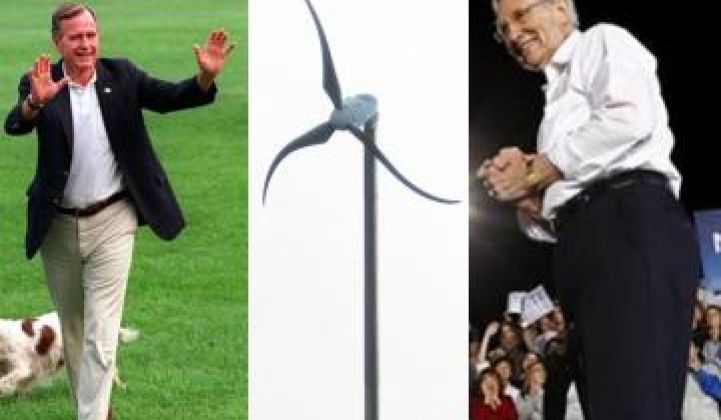Democratic Senator Harry Reid has one in Searchlight, Nevada, and Republican former President George H.W. Bush has one in Kennebunkport, Maine.
Small wind turbines -- machines with a nameplate capacity of 100 kilowatts or less -- are turning up in backyards and at small businesses. U.S. sales for small wind sector in 2009 (the most recent numbers) increased fifteen percent from 2008 to $82.4 million, on almost 10,000 units. Compared to solar, or standard wind, that's miniscule. Still, that was in the heart of the recession.
Southwest Windpower (SWWP), the biggest among the world’s 250 small wind makers and the 95 manufacturers in the U.S., has sold 170,000 turbines since its 1987 founding. Andrew Kruse, SWWP’s Founder and Senior Vice President of Business Development, said his company foresees a coming U.S. market worth two billion to seven billion dollars -- and that may not be the real small wind growth opportunity.
The sector emerged in the late 1990s. “In the big picture, this industry is only about ten years old,” Kruse said, “It is evolving. Last year, half our revenue was towards grid-tied and half of it was battery charging. We still do a lot of work with telecoms, sail boats, offshore platforms and things like that. But that is changing very rapidly, and we expect this year the grid-tied market will be a much larger part of our business.”
Problems, though, abound. Unlike solar panels, small wind turbines rely on moving parts, and moving parts break down. Maintenance, inevitably, will loom as a larger issue. Wind is also a more variable resource than sunlight. To top it off, neighborhood wind advocates have to face off against neighbors afraid of turbine noise and accidents.
Before the introduction of the Skystream 600, SWWP’s newest machine, Skystream 3.7 was its product. “For the newest Skystream, what we’ve done is increase the swept area by one meter. When we do that, we essentially double the swept area. That’s resulting in a performance improvement of approximately 70 percent,” Kruse said.
The 600’s list price is approximately $17,500, installed. “We’re seeing just a phenomenal amount more energy in a machine that costs maybe fifteen percent more.”
With certain modest assumptions about siting and wind speeds, Kruse said, the 600 can produce electricity “that would be equivalent to about eleven cents per kilowatt-hour,” a rate that matches “the standard cost of electricity in the United States. And if you add the 30 percent ITC and state incentives, that number could be far lower depending on what state you live in.”
The American Wind Energy Association (AWEA) estimates the cost of electricity generated by an “average” well-sited small turbine at fifteen to twenty cents per kilowatt-hour.
"It’s all how we get this more cost-effective. We love incentives,” he said. “Even though the fossil fuel industry has had incentives for almost a century, we realize that in the long term, our resources are the sun and the wind and we want to be able to get there with just technology.”
Of the new turbine, Kruse said, “the basic look of the 600 is the same as the 3.7, but a lot of things have evolved over the last five years.” In the new turbine, he explained, there is a web-based monitoring system. “You hook up the Skystream and you plug in this little box,” he said, “and you can see your turbine anywhere. Or, if you allow us to, we can see it and provide updates to the machine for performance.”
Kruse said the 600 is essentially a smarter turbine. Through its interactive Skyview system, “We can look at the power curve that’s being generated,” he said. “The turbine can also tell us what the wind speed is, from about four meters per second to about seventeen meters per second. Knowing what the wind speed is, we can correlate it to performance. Given that data, we can actually change the software to optimize the performance of the machine” according to prevailing weather patterns.
Such prevailing patterns also determine whether a site is best suited for rooftop solar panels, an SWWP turbine or both. Kruse said the company’s dealers are trained to work with customers to make that decision.
“In the off-grid area, we know for pretty much any square kilometer in the country what the wind resource is.” At the SWWP website, “the first question is, ‘Is wind right for me?’ The idea is to engage people and help them decide if it’s the right solution for them. If not, we gladly recommend solar.”



